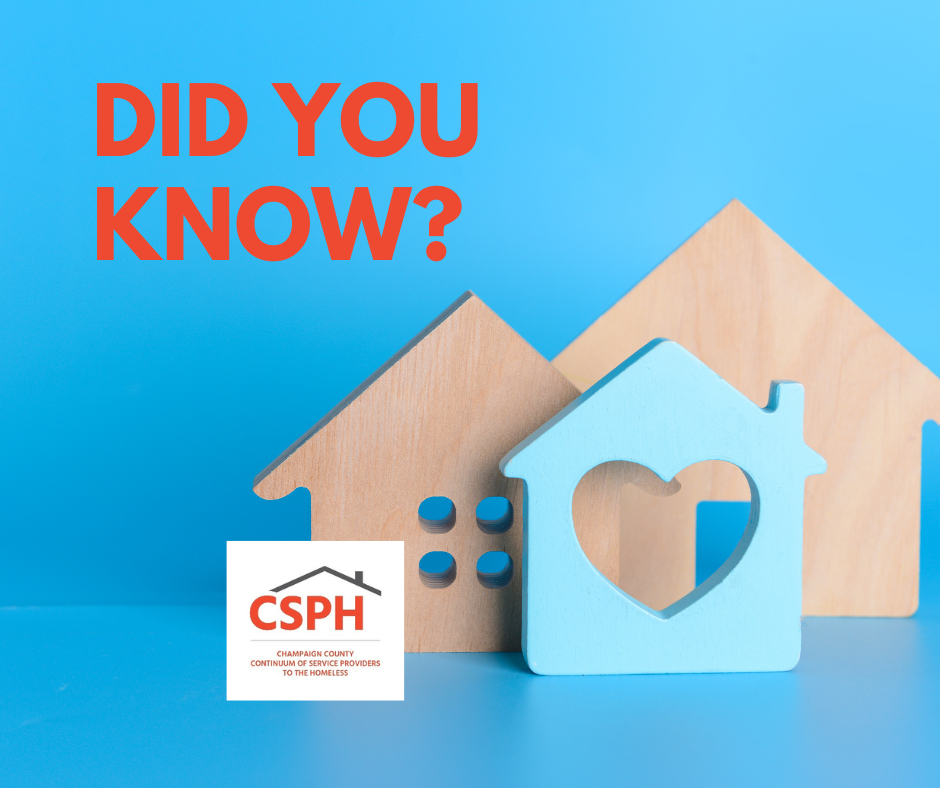Homelessness Rise Reveals Need for Services

Rise in Champaign County Homelessness Reveals Continuing Need for Investments in Homeless and Housing Services
Point-in-Time Count conducted in January shows an increase of 64 homeless individuals and 46 homeless households in the county over 2023 totals
A total of 279 individuals were identified as homeless in Champaign County during the most recent Point-in-Time (PIT) count, an increase of 64 from the 215 individuals identified through the count in January 2023. The count was conducted by the Continuum of Services Providers to the Homeless (CSPH) on January 24, 2024, with more than 40 volunteers split into teams to locate people experiencing homelessness in Champaign County.
Of those individuals, 42 were unsheltered and 152 were sheltered in emergency shelters and 85 in transitional housing. “The PIT count provides community stakeholders with important data that helps us more effectively meet the needs of individuals and families experiencing homelessness in Champaign County,” says CSPH Chair Breaden Belcher. “This year’s data shows the importance of ongoing investments in homeless services and high-quality affordable housing in our community.”
The U.S. Department of Housing and Urban Development (HUD) requires the PIT count annually in late January in order to provide a snapshot of the state of homelessness throughout the country. PIT count data is then utilized to inform federal funding and policy regarding homelessness, such as The Federal Strategic Plan to Prevent and End Homelessness, which the U.S. Interagency Council on Homelessness (USICH) released in December 2022. Additionally, President Biden’s FY2024 budget called for Congress to make common sense investments to lower rental costs and address homelessness, including guaranteed vouchers for low-income veterans and youth aging out of foster care—two groups at higher risk of homelessness.
HUD sets the counts for winter to account for seasonal and overflow beds, as well as to facilitate deduplication between the sheltered and unsheltered counts. HUD does not fund the coordination of counts outside of the last 10 days of January.
“This year we implemented an enhanced unsheltered Point-in-Time count protocol,” says CSPH Coordinator Katie Harmon. “This included canvassing additional areas that homeless services providers and street outreach workers identified as locations that people who are unsheltered frequent. Additionally, we partnered with various homeless service providers to conduct follow-up counting through the end of January to survey people accessing homeless services and identifying if they were unsheltered on the night of our Point-in-Time count. Through these enhancements in our Point-in-Time count methodology, we were better able to identify people who were unsheltered on the night of the count.”
With the assistance of community volunteers, CSPH, a consortium of agencies and governmental units committed to ending homelessness in Champaign County, conducted the count blitz-style concurrent to counts of people in emergency shelters to reduce duplication. Working in teams, the volunteers searched the community for individuals and families experiencing homelessness and gathered information about their housing situations. PIT focuses on, but is not exclusive to, known locations of people experiencing homelessness as identified by people experiencing homelessness, CSPH partners, law enforcement, and others.
The count included people both sheltered (residing in emergency shelters or transitional housing for individuals experiencing homelessness) and unsheltered (living in spaces not meant for human habitation, such as cars or on the street).
Concurrent to the PIT count, the Continuum also completed a count of housing for people experiencing homelessness through the Housing Inventory Count (HIC), which tracks housing projects exclusive to people experiencing homelessness, as defined by HUD. The 2024 HIC showed a decrease in emergency shelter beds while revealing significant increases in transitional housing beds and permanent housing beds. Harmon says that the increases are due to multiple projects being reclassified from emergency shelter to transitional housing this year. This adjustment better represents that these service providers have expanded to offering more resources and greater flexibility in length of stays to people in their programs.
Rapid rehousing beds remained unchanged over the last year. Much of the overall increase in this year’s bed capacity can be attributed to additional state funding awarded to address homelessness. From 2023 to 2024, CSPH’s ability to provide year-round shelter and housing to people experiencing homelessness increased by about 10 percent, primarily as a result of additional state funding to address homelessness. Completed annually, these counts help local homeless service providers track progress towards ending homelessness in our community by measuring the effectiveness of existing services and identifying additional approaches for shelter and housing options.
About the Champaign County Continuum of Service Providers to the Homeless
The Champaign County Continuum of Service Providers to the Homeless (CSPH) is a consortium of 44 non-profit and government agencies, faith-based organizations, and businesses committed to ending homelessness in Champaign County. CSPH welcomes new members, including agencies, faith-based groups, businesses, and interested community members searching for rewarding volunteer opportunities. The Continuum meets on the first Tuesday of every month at 3pm. Those interested in joining can contact Katie Harmon at 217-239-5942 or kharmon@ccrpc.org.
